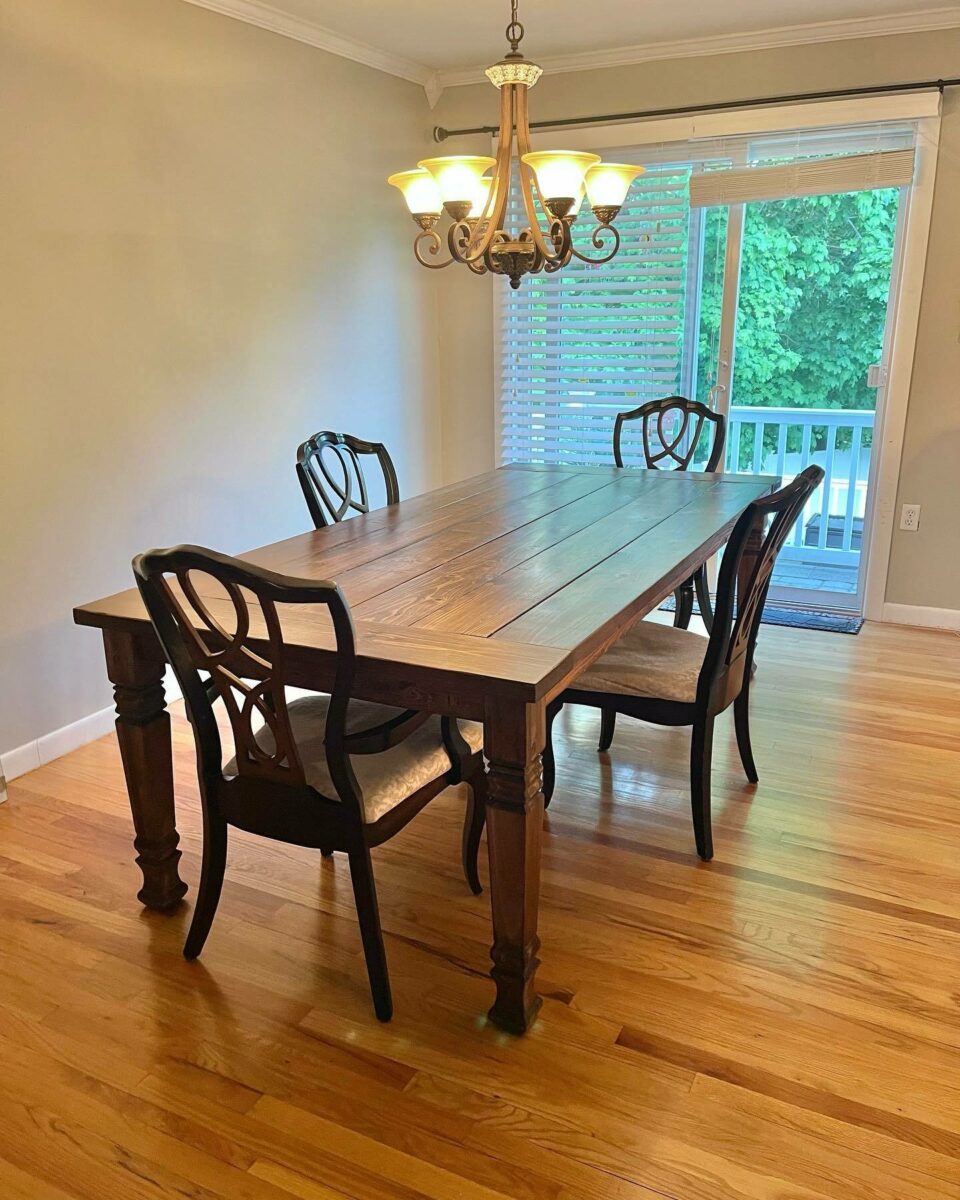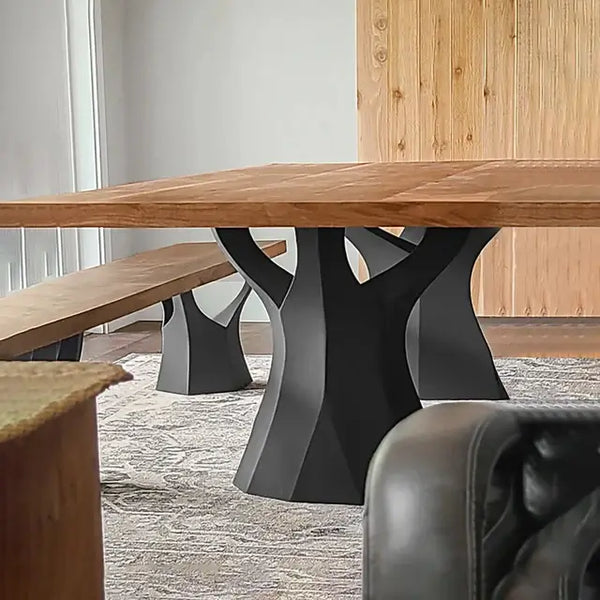Why Custom Dining Room Table Legs Are Worth the Investment
Why Custom Dining Room Table Legs Are Worth the Investment
Blog Article
Exactly How to Choose the Perfect Dining-room Table Legs for Your Home Design
Choosing the ideal dining room table legs is a nuanced process that requires mindful factor to consider of different components, including your room constraints, visual choices, and sensible needs. The interplay in between measurements, styles, and materials can considerably influence the atmosphere of your eating location, making it necessary to approach this choice methodically.
Assess Your Dining Space
Examining your dining room is important for selecting the right table legs that enhance both looks and performance. Begin by determining the dimensions of your dining location, consisting of ceiling height, floor space, and proximity to various other furniture. This info will certainly assist figure out the appropriate size and height of your dining table, which directly affects the option of table legs.
Following, think about the style and design of your eating area. For example, an open-concept design may take advantage of table legs that supply visual agility, such as slender steel or acrylic alternatives. Alternatively, an extra conventional setup could ask for durable wood legs that offer a feeling of permanence.
Assess the existing color scheme and materials in your dining area. Harmonizing the table legs with these aspects produces a natural look that boosts the total style.
Ultimately, a detailed assessment of your eating space will assist you in making an educated decision, guaranteeing that your table legs not just improve the aesthetic allure but additionally offer practical functions.
Consider Your Design Preferences
When choosing dining area table legs, it is important to review your personal design preferences, as they significantly influence the overall aesthetic of your dining room. Your option of table legs can either enhance or comparison with existing decoration, making it important to straighten them with your favored interior decoration theme.
If your home leans towards a contemporary visual, take into consideration sleek steel or minimal wood legs that offer a clean, clean appearance. For a much more standard technique, ornate wood legs with intricate makings can include a touch of elegance and refinement. Industrial styles take advantage of durable, resources such as recovered wood and steel mixes, showing a tough beauty.
In addition, farmhouse and rustic styles typically prefer strong, beefy legs that evoke a feeling of warmth and convenience. Conversely, if your decoration is eclectic, you could pick non-traditional shapes or a mix of products to develop visual rate of interest.

Evaluate Material Options
The option of product for eating room table legs plays a pivotal role in both durability and visual charm. Usual materials include wood, metal, and composite alternatives, each offering distinct attributes that can affect the overall look and long life of your table.
Wood is a traditional option, understood for its warmth and adaptability. Woods like oak and walnut give extraordinary toughness and can be ended up in numerous discolorations to match any type of design. Nonetheless, softwoods like want are much more susceptible to scrapes and dents, making them less perfect for high-traffic locations.
Metal legs, commonly crafted from steel or light weight aluminum, exude modernity and industrial beauty. They are very sturdy and resistant to wear, making them appropriate for families with kids or regular events (dining room table legs). Furthermore, steel can be ended up in different colors, enhancing the customization possibilities
Composite materials, such as MDF or laminate, offer price and diverse designs. While typically much less durable than strong wood or steel, they can still supply a trendy look and are usually very easy to maintain.
Eventually, the product you pick should line up with your way of living, aesthetic preferences, and the degree of usage your table will certainly experience.
Determine Elevation and Dimension
Choosing the suitable height and size for your dining-room table is crucial for both functionality and comfort. The common height for dining tables normally ranges from 28 to 30 Recommended Reading inches, permitting adequate legroom for a lot of individuals when seated. It is important to consider the dimensions of your dining space and the types of chairs you intend to use.

In addition, consider the percentages of your eating area. A larger table in a sizable area can create a grand setting, while a smaller table works well in even more intimate settings. Eventually, the ideal elevation and dimension will certainly balance with your overall design and enhance the eating experience for you and your guests.
Explore Modification Opportunities

Additionally, the style of the legs can be personalized to fit numerous designs, such as rustic, contemporary, or industrial. For example, tapered legs can evoke a mid-century contemporary feeling, while beefy, block-style legs may reverberate with traditional or farmhouse style.
House owners can likewise check out color finishes, from all-natural wood spots to repaint, enabling them to match or comparison with the tabletop and bordering decor.
Furthermore, leg elevation can be gotten used to suit details seating arrangements or personal choices, improving both convenience and functionality.
Last but not least, unique decorations, such as carvings or decorative braces, can additionally individualize the table legs, making the dining experience not just a dish however a statement item in the home. By taking into consideration these customization choices, house owners can develop a dining-room table that truly mirrors their originality.
Verdict
Picking the suitable dining-room table legs calls for cautious consideration of different elements, consisting of the dimensions of the eating space, design preferences, product toughness, and preferred height. Modification choices further boost the capacity to achieve a natural aesthetic that complements the overall style. By systematically assessing these components, home owners can guarantee that the chosen table legs not just fulfill useful demands yet also contribute favorably to the dining experience and setting of the home.
Picking the perfect dining room table legs is a nuanced procedure that requires cautious factor to consider of different components, including your area restraints, aesthetic choices, and functional needs.Assessing your eating area is crucial for picking the right table legs that match both visual appeals and functionality.When figuring out size, gauge the area where the table will be positioned to ensure it fits conveniently, allowing for at least 36 inches of this link clearance around the table for very easy activity. A larger table in a roomy area can develop a grand setting, while a smaller sized table functions well in even more intimate setups.Choosing the suitable eating room table legs calls linked here for careful factor to consider of numerous variables, consisting of the measurements of the dining space, style choices, product resilience, and desired height.
Report this page